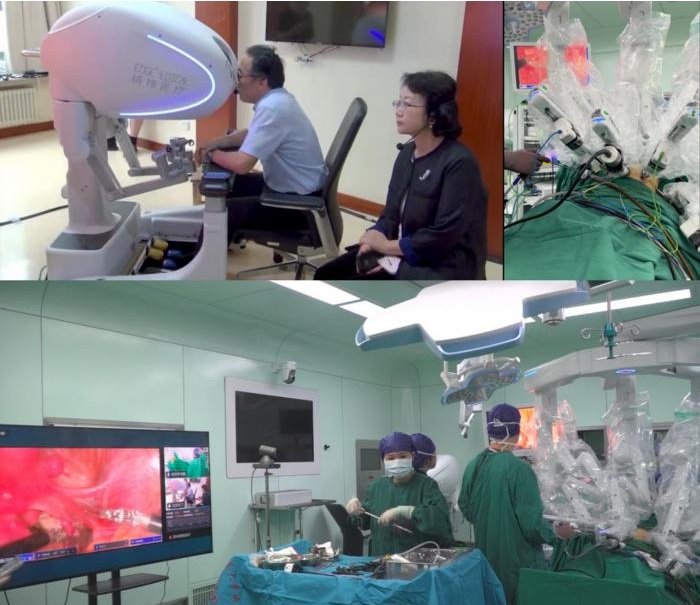Endoscopic Surgical System Enables Remote Robot-Assisted Laparoscopic Hysterectomy
|
By HospiMedica International staff writers Posted on 21 Nov 2024 |

Telemedicine enables patients in remote areas to access consultations and treatments, overcoming challenges related to the uneven distribution and availability of medical resources. However, the execution of remote surgery still faces technical and operational challenges, particularly with data transmission speed and maintaining surgical accuracy. In a significant development, surgeons successfully performed a remote robot-assisted laparoscopic hysterectomy across a distance of 1,200 km using a surgical robot and 5G technology. This surgery, broadcast live over the network, highlights the feasibility of remote surgery and represents an important advancement in telemedicine.
Surgeons located at the Chinese PLA General Hospital (Beijing, China) performed the first globally broadcast remote robot-assisted laparoscopic hysterectomy using the Edge Multi-Port Endoscopic Surgical Robot MP1000 (Edge MP1000) from Edge Medical (Shenzhen, China) and 5G communication technology. The surgical commands were inputted into the console and transmitted through a dedicated data line to the slave console in Wuhan, where they were converted into actual surgical actions. Three-dimensional images from the endoscope at the slave console were sent back in real time to the surgeon's console via the 5G network, ensuring a seamless, closed-loop operation.
The remote communication system of the surgical robot was also equipped to monitor and record both the surgical procedure and network performance, while providing intelligent assistance. According to the study published in Intelligent Surgery, the communication between the two teams was effective, allowing for smooth cooperation and interaction. The patient experienced a smooth recovery and was discharged on the fourth day without any postoperative complications.
“This achieved the specific requirements of low latency, high precision and high reliability for surgical operations,” said Yuanguang Meng, lead researcher of the case report. “Data showed that the bidirectional latency during the surgery was only 19 ms, with a maximum jitter of about 3 ms in rare moments, and a frame drop rate of approximately 0.2%.”
Latest Surgical Techniques News
- Pioneering Sutureless Coronary Bypass Technology to Eliminate Open-Chest Procedures
- Intravascular Imaging for Guiding Stent Implantation Ensures Safer Stenting Procedures
- World's First AI Surgical Guidance Platform Allows Surgeons to Measure Success in Real-Time
- AI-Generated Synthetic Scarred Hearts Aid Atrial Fibrillation Treatment
- New Class of Bioadhesives to Connect Human Tissues to Long-Term Medical Implants
- New Transcatheter Valve Found Safe and Effective for Treating Aortic Regurgitation
- Minimally Invasive Valve Repair Reduces Hospitalizations in Severe Tricuspid Regurgitation Patients
- Tiny Robotic Tools Powered by Magnetic Fields to Enable Minimally Invasive Brain Surgery
- Magnetic Tweezers Make Robotic Surgery Safer and More Precise
- AI-Powered Surgical Planning Tool Improves Pre-Op Planning
- Novel Sensing System Restores Missing Sense of Touch in Minimally Invasive Surgery
- Headset-Based AR Navigation System Improves EVD Placement
- Higher Electrode Density Improves Epilepsy Surgery by Pinpointing Where Seizures Begin
- Open-Source Tool Optimizes Placement of Visual Brain Implants
- Easy-To-Apply Gel Could Prevent Formation of Post-Surgical Abdominal Adhesions
- Groundbreaking Leadless Pacemaker to Prevent Invasive Surgeries for Children
Channels
Critical Care
view channel
Ingestible Smart Capsule for Chemical Sensing in the Gut Moves Closer to Market
Intestinal gases are associated with several health conditions, including colon cancer, irritable bowel syndrome, and inflammatory bowel disease, and they have the potential to serve as crucial biomarkers... Read moreNovel Cannula Delivery System Enables Targeted Delivery of Imaging Agents and Drugs
Multiphoton microscopy has become an invaluable tool in neuroscience, allowing researchers to observe brain activity in real time with high-resolution imaging. A crucial aspect of many multiphoton microscopy... Read more
Novel Intrabronchial Method Delivers Cell Therapies in Critically Ill Patients on External Lung Support
Until now, administering cell therapies to patients on extracorporeal membrane oxygenation (ECMO)—a life-support system typically used for severe lung failure—has been nearly impossible.... Read morePatient Care
view channel
Portable Biosensor Platform to Reduce Hospital-Acquired Infections
Approximately 4 million patients in the European Union acquire healthcare-associated infections (HAIs) or nosocomial infections each year, with around 37,000 deaths directly resulting from these infections,... Read moreFirst-Of-Its-Kind Portable Germicidal Light Technology Disinfects High-Touch Clinical Surfaces in Seconds
Reducing healthcare-acquired infections (HAIs) remains a pressing issue within global healthcare systems. In the United States alone, 1.7 million patients contract HAIs annually, leading to approximately... Read more
Surgical Capacity Optimization Solution Helps Hospitals Boost OR Utilization
An innovative solution has the capability to transform surgical capacity utilization by targeting the root cause of surgical block time inefficiencies. Fujitsu Limited’s (Tokyo, Japan) Surgical Capacity... Read more
Game-Changing Innovation in Surgical Instrument Sterilization Significantly Improves OR Throughput
A groundbreaking innovation enables hospitals to significantly improve instrument processing time and throughput in operating rooms (ORs) and sterile processing departments. Turbett Surgical, Inc.... Read moreHealth IT
view channel
Printable Molecule-Selective Nanoparticles Enable Mass Production of Wearable Biosensors
The future of medicine is likely to focus on the personalization of healthcare—understanding exactly what an individual requires and delivering the appropriate combination of nutrients, metabolites, and... Read more
Smartwatches Could Detect Congestive Heart Failure
Diagnosing congestive heart failure (CHF) typically requires expensive and time-consuming imaging techniques like echocardiography, also known as cardiac ultrasound. Previously, detecting CHF by analyzing... Read moreBusiness
view channel
Expanded Collaboration to Transform OR Technology Through AI and Automation
The expansion of an existing collaboration between three leading companies aims to develop artificial intelligence (AI)-driven solutions for smart operating rooms with sophisticated monitoring and automation.... Read more
















